
Placoderms are vertebrate animals of the class Placodermi, an extinct group of prehistoric fish known from Paleozoic fossils during the Silurian and the Devonian periods. While their endoskeletons are mainly cartilaginous, their head and thorax were covered by articulated armoured plates, and the rest of the body was scaled or naked depending on the species.

Petalichthyida is an extinct order of small, flattened placoderm fish. They are typified by their splayed pectoral fins, exaggerated lateral spines, flattened bodies, and numerous tubercles that decorated all of the plates and scales of their armor. They reached a peak in diversity during the Early Devonian and were found throughout the world, particularly in Europe, North America, Asia, South America, and Australia. The petalichthids Lunaspis and Wijdeaspis are among the best known. The earliest and most primitive known petalichthyid is Diandongpetalichthys, which is from earliest Devonian-aged strata of Yunnan. The presence of Diandongpetalichthys, along with other primitive petalichthyids including Neopetalichthys and Quasipetalichthys, and more advanced petalichthyids, suggest that the order may have arisen in China, possibly during the late Silurian.

Wang Zhiming (王志明) was a Miao pastor little known outside his home in Wuding County, Yunnan, China, at the time of his execution on December 29, 1973. Since then, he has received two unique honors. In 1981, he became the only Christian martyr of the Cultural Revolution to have a monument erected at his gravesite. Then in 1998, he was one of ten 20th-century Christian martyrs memorialized above the Great West Door of Westminster Abbey with a statue. These statues represent those who died in the name of Christ in the century marked by the greatest number of martyrdoms in the history of the church.

Quasipetalichthys haikouensis is the type and only known species of the extinct petalichthid placoderm, Quasipetalichthys. Fossil remains of Quasipetalichthys have been found in the Middle Devonian, Givetian faunal stage of China.
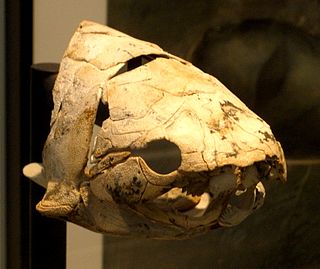
Eastmanosteus is a fossil genus of dunkleosteid placoderms. It was closely related to the giant Dunkleosteus, but differed from that genus in size, in possessing a distinctive tuberculated bone ornament, a differently shaped nuchal plate and a more zig-zagging course of the sutures of the skull roof.

Wuttagoonaspis is an extinct genus of primitive arthrodire placoderm fish from the Middle Devonian of Australia. The box-like skull is up to 18 centimeters in length, and the median dorsal plate averages in length about 10 centimeters. It contains two species: the type species Wuttagoonaspis fletcheri, described by Ritchie in 1973, and Wuttagoonaspis milligani, described by Young and Goujet in 2003.
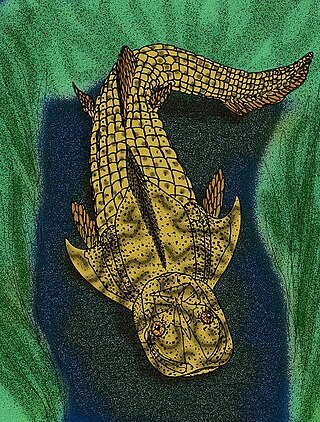
Yiminaspis is an extinct monospecific genus of primitive arthrodire placoderm fish from Emsian-aged marine strata in Yunnan, China. The type species Yiminaspis shenme was named and described in 2008, and is known from a flattened partial skull and portions of the thoracic armor.

Xiangshuiosteus wui is an extinct monospecific genus of brachythoracid arthrodire placoderm from the Late Emsian stage of the Early Devonian epoch, discovered in Wuding County of Yunnan province, China. It has recently been reassessed as a dunkleosteid.
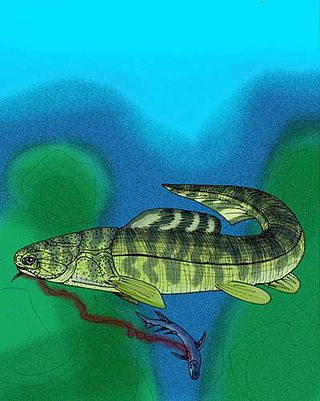
Buchanosteus is an extinct genus of arthrodire placoderm. Its fossils have been found in Early Devonian-aged marine strata throughout Asia and Australia. It contains the following species:

Neopetalichthys yenmenpaensis is an extinct petalichthid placoderm from the Early Devonian of China.
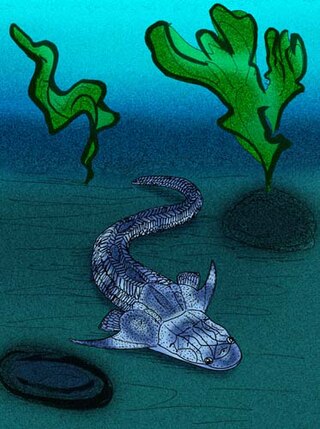
Diandongpetalichthys liaojiaoshanensis is an extinct petalichthyid placoderm from the Early Devonian of China.
Exutaspis megista is an extinct, "giant" buchanosteid arthrodire placoderm. Its fossils have been found in the Late Emsian-aged marine strata of the Jiucheng and Haikou Formations in Wuding, Yunnan.
Phymosteus liui is an extinct large selenosteid arthrodire placoderm known from the Lower Famennian Xiejingshi Formation of Shimen County, Hunan province, in central China.

Qilinyu is a genus of early placoderm from the late Silurian of China. It contains a single species, Qilinyu rostrata, from the Xiaoxiang fauna of the Kuanti Formation. Along with its contemporary Entelognathus, Qilinyu is an unusual placoderm showing some traits more similar to bony fish, such as dermal jaw bones and lobe-like fins. It can be characterized by adaptations for a benthic lifestyle, with the mouth and nostrils on the underside of the head, similar to the unrelated antiarch placoderms. The shape of the skull has been described as "dolphin-like", with a domed cranium and a short projecting rostrum.

Wufengshania is an extinct genus of bothriolepidid placoderm from the Emsian epoch of China. The type species, Wufengshania magniforaminiswas named by Zhaohui Pan et al., 2018.
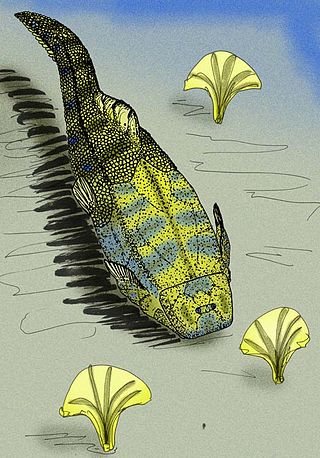
Shimenolepis granifera is an extinct yunnanolepid placoderm from the Xiaoxi Formation, Li County, Hunan, China. Its age is discussed, while originally considered as late Llandovery, it is later considered to belong to the Ludlow Epoch instead. It was the first described Silurian placoderm, and was the earliest known placoderm until Xiushanosteus was described, known from distinctively ordered plates.

Zhanjilepis aspartilis is an extinct yunnanolepid placoderm from Pridoli and Lochkovian rocks of Hunan, China. Zhanjilepis is known only from distinctively ordered plates.
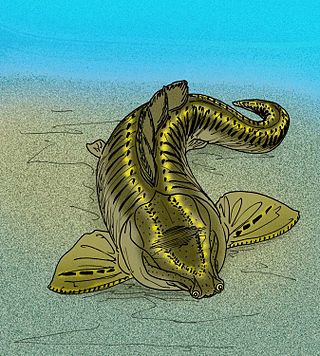
Yinostius is an extinct genus of heterosteid placoderm of the Middle Devonian known from remains discovered in China.

Bianchengichthys is a genus of maxillate placoderm fish from the late Silurian Period. Its fossils have been recovered from Yunnan Province, China, and it is represented by only one species: Bianchengichthys micros.

Bothriolepididae is a family of antiarch placoderms, known from the Emsian, to Famennian.

























